The New Rules of Engagement employee inspiration research report
Written by: BIW Research and Strategy team
(View Author Bio)
Employees who believe their good work will be recognized are 12.4 times more likely to say they have a great company culture.

Foreword
____________________
Science fiction author Isaac Asimov once said, "You don't need to predict the future. Just choose a good future - a useful future - that will alter human emotions and reactions in such a way that the future you predict will be brought about."
____________________
When it comes to engaging and inspiring employees, BI WORLDWIDE believes in a good and useful future where companies make the right investments that bring about increased employee commitment, effort and inspiration.
Following Asimov’s line of thinking, BIW’s annual research study explored various trends in the workplace. We dove into the role of artificial intelligence and how it impacts the way employees feel about their work experience and business outcomes. We looked at how more effective learning can help employees gain additional skills, increasing their confidence in their job performance. This tailored learning can be especially helpful for salespeople who represent their companies in the market.
With the introduction of more high-tech enablement tools, companies will have more opportunities for human interaction that is meaningful. With the help of AI tools, managers can effectively coach, recognize and reward employees. Employees can reduce mundane tasks and recognize their coworkers, heightening their sense of gratitude. And survey results can be analyzed more quickly, allowing for employees to have their voices heard.
At the heart of all this research is The New Rules of Engagement®, BIW’s proprietary model that identifies what companies can offer their employees to encourage them to stay, work hard and feel inspired at work. We update these benchmarks every year, test concepts by listening to what our clients are experiencing and adjust our research accordingly.
____________________
The New Rules of Engagement®
This year, our survey respondents spoke to many trends including recognition, artificial intelligence, communication with their leaders and employer, ESG, deskless employees, remote work, managers, survey feedback and more. All this data wouldn’t fit into one report, so we’re focusing on six keys trends this year:
1. Survey feedback
2. Recognition's impact on culture
3. Recognition's impact on business results
4. Gratitude
5. Artificial intelligence
6. Sales enablement
The research around these key topics can help build concrete strategies for your business. These strategies are grounded in real-world data and experiences and can help create a brighter, more engaged workplace.
____________________
Surveys
Conducting employee surveys won't change company culture - but here's what does.
Psychologist Dr. Donald O. Clifton believed that one of the most important things you can do as a leader is “help people feel heard – genuinely heard.” When it comes to conducting employee engagement surveys, how do you do that? It’s not just about handing out the survey but making sure employees feel their voices matter. BI WORLDWIDE found that most companies survey their employees annually or even quarterly. Technology has made it easier and more cost effective to do surveys more often and companies are doing so with greater frequency, including using focus groups or town hall meetings.
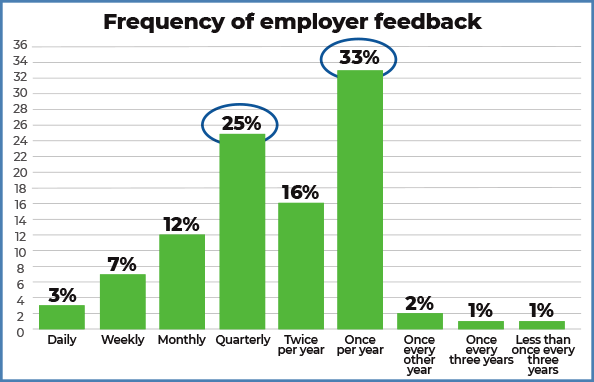
This year, BIW asked participants about the surveys they received from their companies. Ninety-two percent of those who remembered being asked to complete a survey said they provided feedback.
But some companies still worry about “survey fatigue” and lack of participation.
BIW’s research shows this isn’t an issue. Applying common sense when initiating surveys – like not starting more than two at a time – helps to ease those concerns. However the reasons as to why employees didn’t participate in company surveys varied, including:
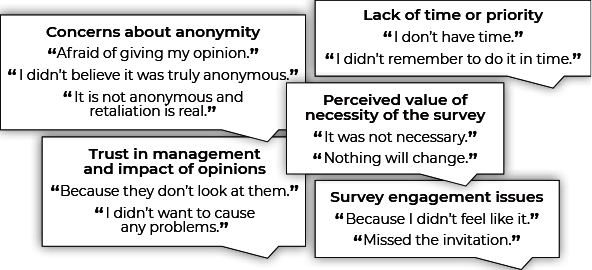
When employees don’t see their feedback making a difference, they might feel less inclined to participate in surveys. Less than half of employees feel that meaningful changes happen as a result of the surveys.
Companies need to understand that when they conduct surveys and ask for feedback, they’re setting an expectation that something is going to happen.
Most employees realize they don’t get everything they asked for, but they do expect action. Failure to act may lead to demoralized employees.
But it’s not all bad news. When companies have meaningful conversations with employees, those employees show higher levels of commitment, effort and inspiration.
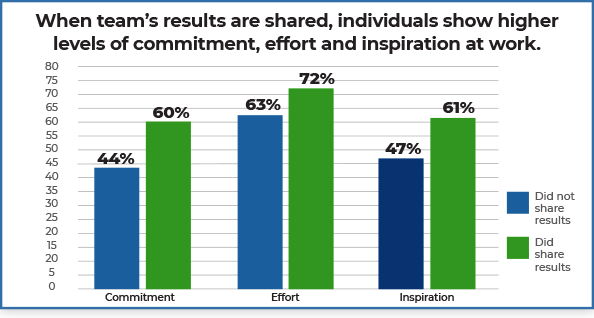
Sharing survey results helps the team go from insights to actions. BIW’s research shows that:
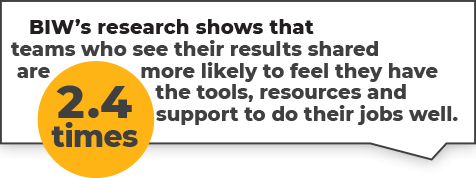
The key is to not delay action on survey results. Employees said the biggest barrier to taking meaningful action is the time between completing the survey and sharing the results. If too much time passes, you risk losing momentum.
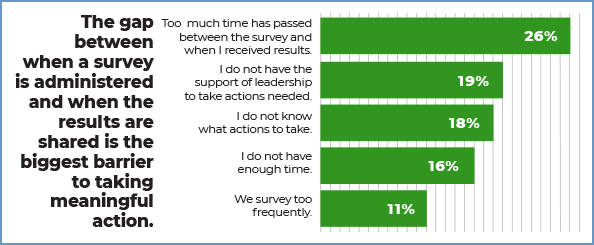
What can you do to make sure you’re making the most of your survey results?
- Ensure surveys measure important, actionable outcomes.
In one case, BI WORLDWIDE was able to help a health services client establish a strong relationship between their survey results and employee retention and patient satisfaction, gaining the attention of leadership.
- Offer confidential feedback opportunities about their results and how they can grow.
There are several tools available for employees to receive confidential feedback that can help them take greater ownership of their engagement. To be sure, creating an engaged culture must be driven by leaders and managers. Providing resources to individual contributors can also help.
- Let employees know they've been heard.
Create an action plan that includes communications from senior leaders to inform employees of the results. Even if some of the results are less than desirable, sharing the results and what you plan to do with them should be an ongoing approach.
- Act on what counts.
Using The New Rules of Engagement® model, BIW conducts an analysis to decide which areas of investment can bring the most return. For some companies, compensation is not the most important area to employees, but rather a sense of belonging and seeing their future are areas to focus on.
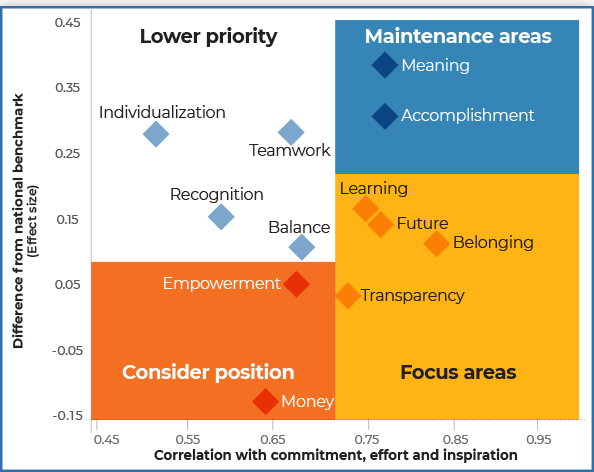
- Train managers to take the right actions.
Changing culture can take time, and managers play an important role in engaging their team members. But managers aren’t often equipped to follow up on survey results. Companies need to provide their managers and leaders with ongoing training and guidance to avoid the belief that they aren’t following up and taking these surveys seriously.
- Celebrate and communicate early wins to build momentum.
Make sure early wins are shared widely to help build momentum and show employees you’re listening to them.
____________________
Mark Hirschfeld, Vice President, Consulting Services and Strategic Partnership
____________________
Recognition's impact on culture
Boost your company culture with evidence-based tactics.
When we think about companies with outstanding cultures, we often imagine trendy office spaces with exposed brick walls, open layouts, free drinks and foosball tables. Similarly, when AI thinks of a great workplace culture, it shows images of young, overly cheerful employees around a reclaimed wood table, surrounded by colorful Post-it® notes.
But employees in large companies know these pictures aren’t reality. Even in offices with regular desks and plain walls, great cultures can thrive. So what makes a great company culture if it’s not espresso machines and other trendy stuff?

Recognition is a key pillar that can influence the other pillars of wellbeing, purpose, leadership and belonging. When done strategically, recognition can make employees feel more valued, healthy, connected, purposeful and trustful of leadership.
Employees receiving recognition and rewards had the biggest gains in terms of feeling valued by their companies, but they also were more likely to feel a sense of wellbeing, belonging, purpose and a trust in leadership.
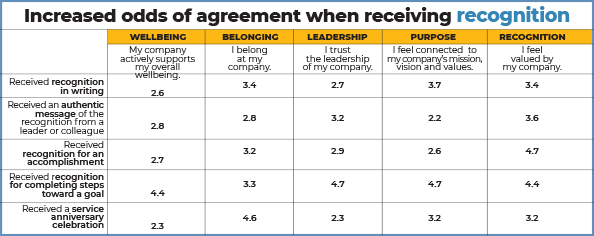
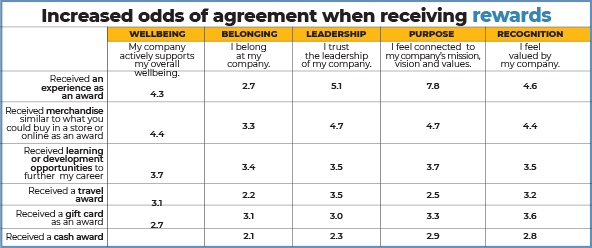
Recognition can also explicitly support your values. What gets recognized gets repeated, so it’s important to tie recognition to behaviors that reflect your company values. Analyzing recognition data can show which values might be misunderstood or underrepresented. For example, a large life sciences client found that one of their core values was only recognized 10% of the time. They launched a communications campaign to educate employees on this value and incentivized its recognition, doubling the recognition of the value and helping to embed it into the company culture.
While every company’s culture is unique, great cultures share common traits: trust in leadership, support for employee wellbeing, a sense of purpose and belonging and effective recognition. Remember, a great culture isn’t about having exposed brick walls – it’s about creating an environment that reinforces these pillars and your specific company values.
____________________
Amy Stern, Vice President, Employee Performance Group
____________________
Recognition’s impact on business results
How does recognition help you reach your big goals?
At BI WORLDWIDE, we help our clients deliver real, tangible results through our recognition programs. When we ask program owners about their big goals, we often hear things like “improve culture” or “create a sense of purpose.” These are great goals, and we can certainly help with them. But that’s not what we’re asking.
We want to know your big goals. Are you trying to launch a new product while phasing out an old one? Do you need to increase your market share or double your revenue over the next five years? Maybe you want to boost your Net Promoter Score by at least 20 points.
Big goals are labeled as such for a reason – they’re challenging to achieve. They require the full attention, focus and commitment of every single employee. In large companies with tens of thousands of employees worldwide, all engaged in different tasks, this can seem daunting. At BI WORLDWIDE, we have a proven framework to help you achieve these big goals.
First, let’s acknowledge that recognition impacts culture.

Recognition also boosts employee engagement. Employees who receive recognition and awards are more likely to feel committed, work harder and feel inspired. A good culture and engaged employees lead to positive business results.
For example, Irrational Capital partnered with Harbor Capital to create a Large Cap ETF based on companies’ culture and engagement scores. This fund has, on average, outperformed the S&P 500 since its inception.
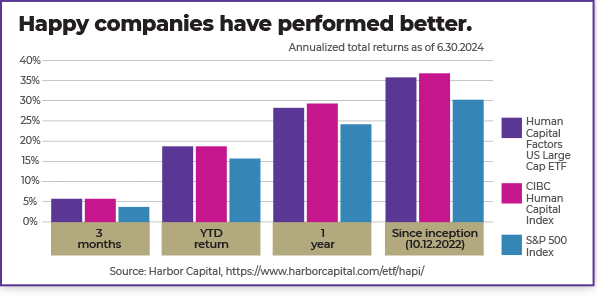
Our data at BIW supports this pattern, showing that companies with better culture, engagement and employee experience also report more financial growth.
However, these are correlations. We can flip the chart and see that companies with higher financial projections also have better cultures and engagement. So does culture drive results or do results drive culture? Our research and client work suggest it’s both. Good culture drives good results, and good results make for a better culture. But even great cultures can have problems. One of our clients with high culture scores experienced a failed project launch, leading to lower scores for the teams involved.
The reality is that culture and business results influence each other. If you’re only focusing on improving culture, you won’t unlock your program’s full potential. Think of building a great basketball team: to win, you need both talented players and team cohesion. A team that focuses on individual skills OR teamwork will perform better than one that focuses on neither. But a team that focuses on both will have far greater success. The same goes for recognition. By fueling this cycle from all sides, we achieve stronger and faster results than by influencing culture alone.
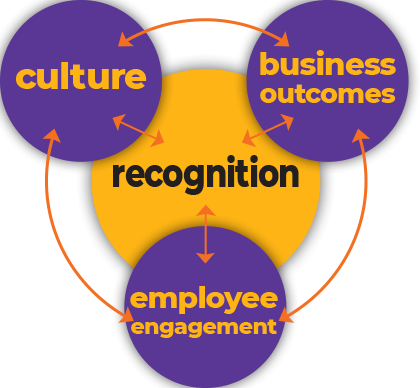
At BI WORLDWIDE, we help our clients by recognizing achievements and supporting culture while driving business results. We use our business improvement process and principles of behavioral economics to understand your strategic goals, key stakeholders and challenges. We then design a program that communicates, educates, motivates and updates employees as they work towards these big goals.
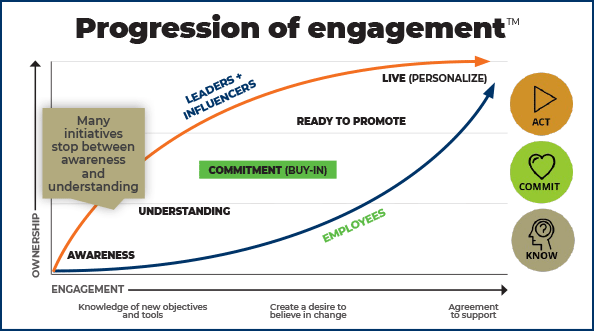
Using this model, we have driven big goals like improving free cash flow, increasing quarterly and annual sales and reducing turnover.
The next time you think about goals for your recognition program, think big. What are your executive team’s priorities? What do you need your employees to do to reach these goals? Then put the model to work: educate, communicate, motivate and update your teams to achieve something great while reinforcing your culture. You’ll create a great workplace and drive significant impact.
____________________
Erin Ekstrand, Managing Director, Client Services
____________________
Gratitude
Gratitude benefits more than just the receiver.
We’re all familiar with receiving recognition and how we feel when we’re recognized. But what’s not talked about as much is how showing gratitude benefits the giver. Giving serves a far greater function than just enabling someone else to receive.
Here are the six benefits of showing gratitude at work:
1. Expressing gratitude has physical and mental health benefits.
For some, recognition feels like just one more thing to add to a stressful plate. But it’s helpful to know that expressing gratitude has benefits on physical and mental health. An article from the Mayo Clinic stated that expressing gratitude can improve sleep, decrease depression and anxiety and decrease difficulties with chronic pain. It also helps improve immunity and connections with others.1
2. Expressing gratitude can improve physiological stress responses in work tasks.
Gratitude has been related to improved stress responses. A study placed university students who had been acquainted for a few months into groups and asked them to individually complete a task typically found in a work environment. They were asked to collaborate on the product design, the marketing plan development and a product pitch. Each team member was required to deliver part of the product pitch to a panel of judges. To raise the stakes the winning team would receive $200.
Before the tasks began, the groups were split into two conditions. Half of the groups included a teammate who was expressing gratitude to the other. The other half of the groups just talked about their days. The study found that the teams who experienced the gratitude condition had superior physiological responses in both the collaborative task and the individual task compared to the control group.2
3. Gratitude promotes culture.
We also see gratitude’s impact in real life, not just in university studies. The New Rules of Engagement® annual research asked questions around gratitude, and we found that those who reported feeling a strong sense of gratitude at work are ten times more likely to say they belong at their company, have a great company culture and would recommend their company as a great place to work.
4. Giving recognition is one way to express gratitude - and it feels great too.
Those who gave recognition in the past month scored 11 percentage points higher on the item “I have so much to be grateful for.” And those who give and receive recognition experience positive emotions after the event, including greater happiness, pride and connection.
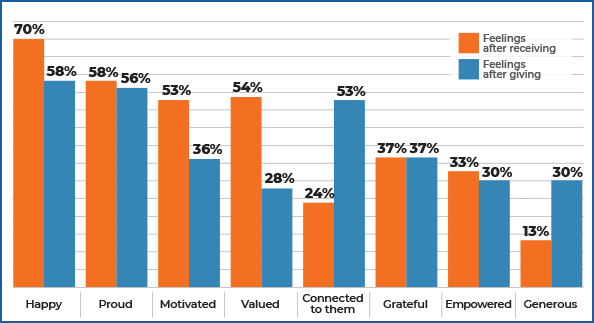
5. Recognition is contagious.
More giving creates a domino effect. Those receiving recognition in the past month are three times more likely to have given recognition in the past month as well. In fact, whether someone received recognition in the past month was the best predictor of whether they gave recognition, an even stronger predictor than how often they report typically recognizing colleagues.
6. Witnessing gratitude spurs prosocial behaviors.
Academic research also suggests that those viewing recognition are more likely to build connections and exhibit helpful behaviors with givers and receivers, creating the culture we want to see at work and opportunities for them to be recognized.3
So what can you do to help drive gratitude at work? Reflect on what you’re grateful for at work – both the little things and the big things – and recognize your teammates. Celebrating gratitude as a team and setting a goal to express gratitude can spur others to do the same.
____________________
Stephanie Hanlon, Senior Account Director, Life Sciences and Healthcare
____________________
Artificial intelligence
To bot or not to bot - embracing the hope (and the concerns) of AI.
Artificial intelligence (AI) tools are already influencing our world, especially at work. At the 2024 HR Tech Conference, industry analyst Josh Bersin said that with fewer people being born, companies will be operating with fewer employees and may need to rely on AI more often. He also said AI will be incredibly important for the labor market, employee experience and employee reskilling, pointing out that AI tools today are much more advanced than before.4
With these changes, how do employees feel about AI? What's the best way to teach them about it?
BI WORLDWIDE asked employees about AI tools like ChatGPT at work. About half of the respondents have been using AI regularly. This acceptance pattern is similar to previous digital transformations like the Internet and social media.
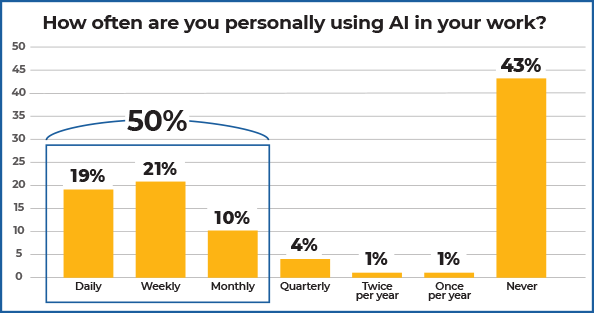
Participants see opportunities in AI coming into the workplace AND voice concerns.
While AI can make work more efficient and innovative, there is concern about job loss and unethical use.
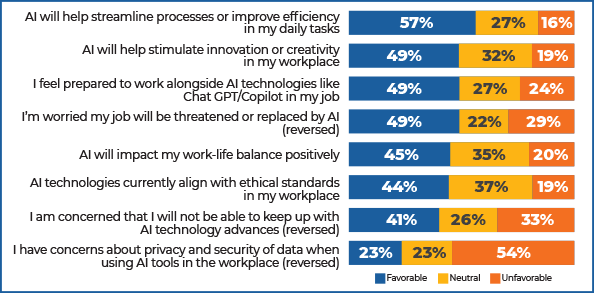
More experienced users view AI in the workplace differently than infrequent users.
Hands-on experience with AI changes people’s view. Frequent users see more benefits in AI improving performance and innovation, while less frequent users don’t see as many.

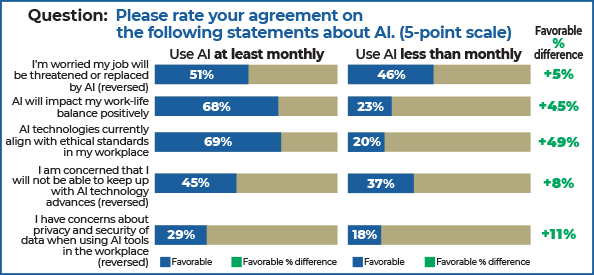
When employees worry about AI taking their jobs, they are half as likely to feel committed at work. Companies need to address these fears to keep their employees.
How do we address concerns and take advantage of opportunities with such new technology? Artificial intelligence is a new tool that needs a thoughtful plan, but companies can learn from decades of digital transformation knowledge. A recent study funded by Workday identified four key elements to support using this generation of digital tools.5
1. Be transparent: Be open about issues like data security, bias, and job loss.
2. Increase training: Employees using AI feel more positive and are more likely to help with innovations.
3. Target communications: Create different messages for frequent versus new users of AI. Managers who have not readily embraced AI will need different messaging than individual contributors.
4. Listen to feedback: Use a two-way feedback loop to understand and address employee concerns that may arise.
Examples of success with AI
Along with these best practices, there are many companies using these principles and achieving important business results. For example, a large firm with a dedicated call center to address HR issues created an AI chatbot to answer common questions, freeing up employees to handle more complex issues. This has led to quicker HR response times, higher job satisfaction from the call center employees and overall satisfaction with HR responses. With the overall call center volume reduced, qualified representatives are being retrained to support important roles that weren’t being adequately staffed, easing concerns about job loss.
Another example comes from a national retail chain that saw a significant increase in how customers were being helped when calling a store. The company used a firm to monitor calls and provide performance feedback to store managers and employees. This approach had some benefits, but the solution was expensive, and some participants expressed concerns about the fairness of the coaching. Instead, the company implemented an AI tool to assess calls and provide more immediate feedback that employees felt was less biased. It also freed up managers to coach and support employees. The AI tool identified high call volume windows and routed calls to a call center to handle scheduling services, reducing costs and improving customer service.
IBM uses its own AI platform, watsonx, for productivity improvements. Steve Moss, Director of watsonx Americas for IBM, noted that 80% of their top IT issues are being addressed by AI, and over 10 million yearly interactions with HR are fully resolved by AI. IBM also saved $165 million in annualized operational savings and 26,000 hours across procurement processes using AI.6
BI WORLDWIDE used an AI tool to analyze comments for The New Rules of Engagement® survey, which is an analysis of unstructured data. The methods for analyzing unstructured data have been in place for over 80 years and are highly reliable, but the process is incredibly time consuming. BIW tested the tools against our proven methods and found them to be accurate in generating a solid draft of results to which our analysts can add their insights. Additionally BIW uses AI to support our customers in their programs, including data protection, bias elimination, program administration reduction and learning program enhancement.
AI tools are here to stay and will continue changing the workplace. Using them well and addressing concerns will create a more engaging, productive work environment. “To bot or not to bot” really isn’t the question; we’re going to use AI, so let’s do it right.
____________________
Beth Sundberg, Vice President, Technology Solutions Group
____________________
Engaging the sales audience
Genuine sales enablement – making the impossible actually possible.
There are over twelve million sales employees in the United States, making it one of the biggest job categories we study. But selling is tough, even for the best salespeople. Companies need to create a good environment for their sales reps in the market. They need their reps to build strong relationships and turn customers into advocates.
Financially successful companies have more engaged sellers.
As a part of The New Rules of Engagement® survey this year, BIWORLDWIDE asked sales representatives about their engagement levels based on the four outcomes of commitment, effort, inspiration and overall engagement. They were also asked how their companies were doing financially: better, worse or the same as the prior year.
Three in every four sales reps who said their companies are doing much better financially reported higher levels of commitment, effort, inspiration and overall engagement. Those who said their companies are doing worse than the previous year have much lower levels of commitment and engagement.
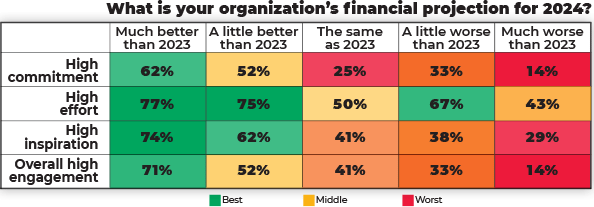
Creating a more engaging work environment can boost business success, including sales. While more engaged employees produce better business results, the relationship goes both ways. It’s more fun to sell for the winning team, so better business results also lead to more engaged employees.
____________________
The right tools help our sales representatives get the job done.
Sales reps need the right tools to sell more. With the right tools, they are fifteen times more likely to be engaged at work and ten times more likely to be committed to their job. For example, a publicly traded pharmaceutical client’s compensation plans performed well through most of the quarter, but the SPIFF wasn’t generating end-of-quarter activity. BIW reimagined the SPIFF program with inspiring non-cash rewards which gained the attention of the salespeople and produced significantly better end-of-quarter results. In the medical device and pharmaceutical fields, sales compensation programs can be complicated. There’s a good business case for more complicated plans, but they often create confusion with sales reps and sales managers regarding what to do, when to do it and why.
Artificial intelligence is an emerging trend in sales enablement. In The New Rules of Engagement® study, salespeople had less experience with AI tools on average than other groups. Half of all study participants were using AI tools monthly compared to only one third of salespeople. There are consequences for salespeople who don’t use AI tools. They are less likely to see how it can streamline their work and more likely to worry about it affecting their jobs.
Salespeople who feel a great sense of belonging are generally more engaged.
Of all the factors in The New Rules of Engagement® model, Foster Belonging has the strongest correlation to sales. Sales reps who feel they belong are far more likely to say they are committed to, inspired by and working hard for their employer.

One client launched a program to increase belonging among their salespeople. The program had received little interest or engagement because it was optional, and most employees chose the “not interested” option. One principle of behavioral sciences is to provide activities in a way where the audiences feel an idiosyncratic fit – the feeling they have a chance of being successful. Using this principle, BIW’s Research & Strategy and Communications teams developed a program that offered awareness and learning activities to address the lack of program participation.
BIW conducted pre- and post-program surveys over the yearlong duration. All engagement metrics increased by a statistically significant extent, including attitude and behavior indicators. The results also showed that when a manager was involved in the program, their direct reports were far more likely to be involved.
Salespeople who are thriving are more likely to stay.
Sales is a challenging job, and stress comes naturally with that job. But too much stress can take a toll and cause sellers to make a “happiness decision” where they leave the company. When companies are committed to helping their salespeople thrive, the salespeople are 7.9 times more likely to be committed to staying with the company.
Many times, companies create unnecessary stress. Salespeople are often inundated with communications from various parts of the company who want the attention of the sales force. The reps are often confused where to find information, who can help them and how they can access other sources of data to do their jobs.
In the previous belonging case study, BIW also studied if communications were being seen and responded to, as that would provide an early indicator of the results achieved. The belonging campaign broke through the clutter and drove participation among salespeople. The right communications plan led to increased understanding and engagement.
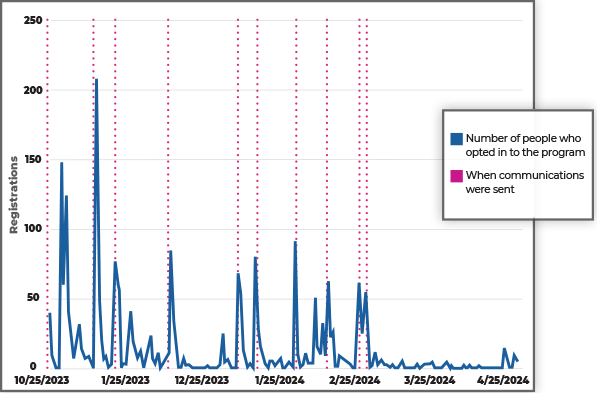
Salespeople who are learning produce results.
Learning and development are also tools to enable sales reps to do their jobs well.

Data from a transportation industry client shows how important learning and development is to achieving results. Over three years, the company tracked sales performance against learning completion. Sales reps that took advantage of ALL learning opportunities significantly outperformed those who took some or none of the courses. Completing learning courses dramatically increases sales success. Investing in the development of sales reps can have a huge impact on the bottom line.
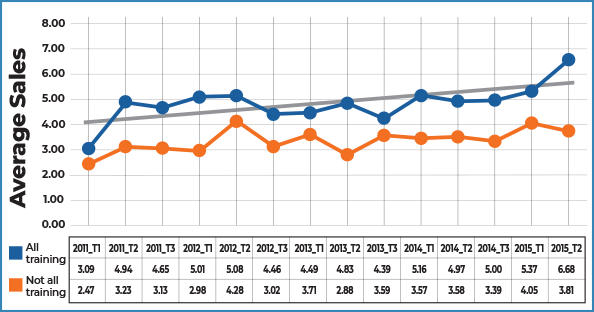
Store associates of a retail client needed to learn how to introduce customers to their branded loyalty program. When customers sign up for the program, their loyalty to the brand increases, so this was an important effort for the retailer.
BIW created a learning program using proprietary gamification tools of leaderboards and missions where retail associates were educated on how to speak with customers about loyalty benefits. These missions allowed associates to earn points redeemable for non-cash rewards. When associates engaged with the website ten or more times, their loyalty enrollment rate was double those who didn’t. Those who earned and redeemed points were so inspired by the process that they were more likely to achieve their goal more quickly the second time. Associates whose managers participated were more likely to also participate, and new employees who engaged in the program were able to catch up quickly to more tenured associates. The results were the same across the retailer’s different brands, showing the power of the program regardless of the store concept.
Providing opportunities for salespeople to learn – based on what they believe to be of value – can have a significant impact on them staying and producing in the market.
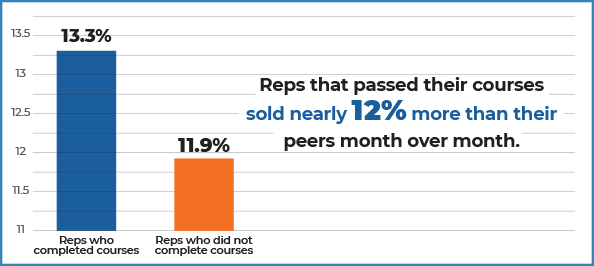
What salespeople value in rewards.
BIW’s research over many years has found that redeemable rewards points are a great motivator for salespeople. One example is a direct sales organization that offered a voluntary certification program. Reps who completed the certification and received points for doing so experienced much higher sales.
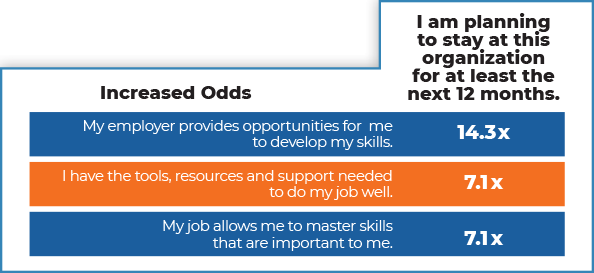
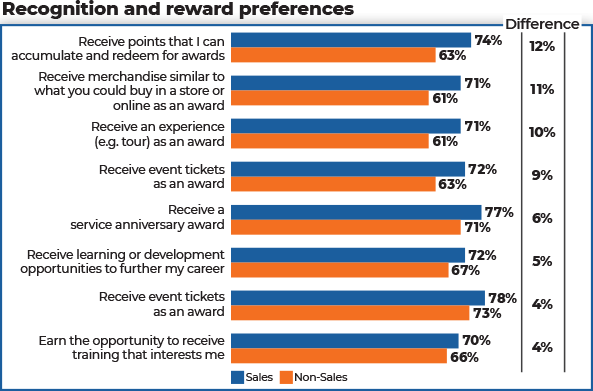
Companies rely on their salespeople to present their goods and services to the market in a way that creates raving fans. They need to provide the right infrastructure and tools to support a salesperson’s efforts. It’s about creating a culture where salespeople feel they belong. It’s about cutting through the clutter and getting them the right information at the right time. And it’s about developing a learning culture where they can speak confidently to customers. Following these practices can increase the chances of making the impossible actually possible for your salespeople.
____________________
Molly Anderson, Senior Account Manager, Employee Performance Group
____________________
Conclusion
In discussing the future, Isaac Asimov concluded, "Better to make a good future than a bad one."
BI WORLDWIDE’s insights lead us to challenge each other to create that good future, one where employees:
• Know how to use AI tools to be more productive and see them as trusted sources
• Believe they are heard and that meaningful progress will be made based on their feedback
• Can experience meaningful recognition that leads to increased business results
• Will feel a genuine sense of gratitude in their workplace
Building a positive workplace culture is a continuous journey that requires commitment and collaboration from everyone in the organization to foster a culture of trust, respect and innovation. These efforts not only improve employee satisfaction and retention but also drive better business outcomes. As you implement these practices, you’ll see how small changes can lead to big improvements.
With dedication and the right tools, you can create an environment where employees are excited to come to work every day, feel valued for their contributions and are motivated to achieve their full potential.
Appendix
BI WORLDWIDE partnered with a panel company in the United States to target employees of companies with 1,000 employees or more. After completing data quality procedures, a total of 1,056 surveys were included. Employees came from over 20 different industries, including healthcare, retail, technology, transportation and finance.
The data were balanced to reflect the age, gender and ethnicity of full-time U.S. employees as outlined by the Bureau of Labor Statistics. Forty-eight percent of respondents were female while 52% were male. The average respondent age was 43.3 years with a standard deviation of 13.9 years.
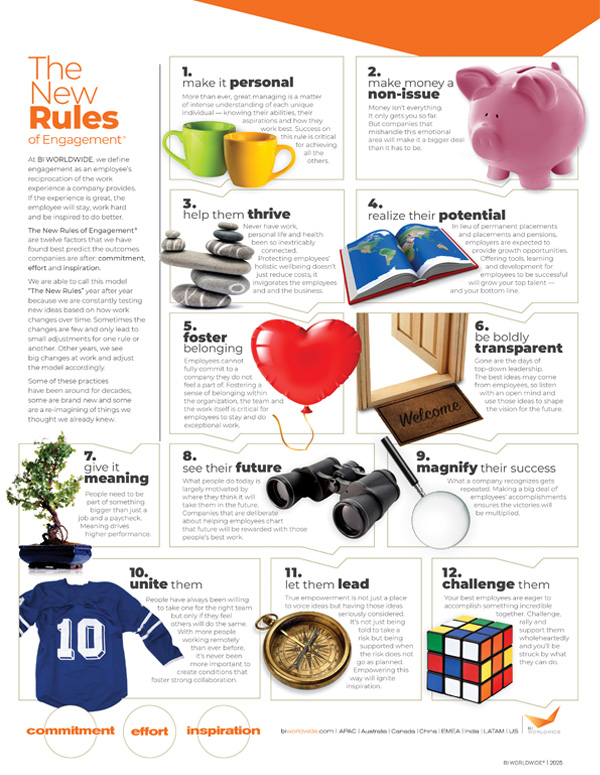
____________________
Additional sources
1. Logan, A. (2022). Feeling grateful improves health. Mayo Clinic.
2. Gu, Y., Ocampo, J. M., Algoe, S. B., & Oveis, C. (2022). Gratitude expressions improve teammates’ cardiovascular stress responses. Journal of Experimental Psychology: General, 151, 3281–3291.
3. Algoe, S. B., Dwyer, P. C., Younge, A., Oveis, C. (2020). A new perspective on the social functions of emotions: Gratitude and the witnessing effect. Journal of Personality and Social Psychology, 119, 40-74.
4. Colletta, J. (2024). Josh Bersin’s top AI headline for 2025? It’s all about the agents. HR Executive.
5. Kircher, A. (2023). How do employees feel about AI at work, and what can you do? Workday.
6. Moss, S. (2024). A Month in IBM Sales: Becoming Client Zero. LinkedIn.
Ready to get to work?
















